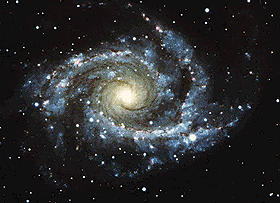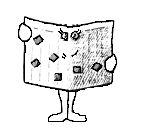AstroCappella: HST-Bop

How Many Stars in the Milky Way?
An activity by Kara C. Granger
Activity Summary:
Can you count every star that Hubble Space Telescope can observe in the Universe? Or even in our own Milky Way? During this activity, students will learn about a statistical method called `sampling' to count to large numbers by using the characters on a newspaper page.
Objective:
Students will perform an experiment in which they will use a statistical method called `sampling' to count to a billion (and beyond).
Materials for each group of students:
- 1 page of classified ads from the newspaper
- 1 piece of cardboard paper ~ 4cm X 6cm
- scissors
- calculator (optional)
Introduction
Step out during the early evening on a clear, moonless winter night in the mountains or in the desert, and you will see a faint milky band of light stretching across the heavens directly overhead. It is light from the billions of stars in our Milky Way Galaxy. The Greek scholar Democritus was the first to guess the true nature of the Milky Way in the fourth century B. C. He wrote, "It is a luster of small stars very close together." It remained for Galileo to turn his new telescope to look at the Milky Way in 1610 to prove that Democritus had been right!
Strangely enough, however, in some ways we know less about our Galaxy than some of those farther out in space because we cannot view it from outside. Interstellar dust clouds prevent us from seeing very far into the Milky Way Galaxy even with the use of our most powerful optical telescopes, such as the Hubble Space Telescope. Observations in other regions of the electromagnetic spectrum have allowed us our best glimpses into the heart of our Galaxy. Some scientists hypothesize that a mysterious source, such as a massive black hole, lies at the center of the Milky Way. Based on more recent evidence, some scientists have theorized that the nucleus consists instead of a very dense concentration of stars, some of which are colliding. Intensive exploration of our Galaxy continues and we can expect to continue to read about new discoveries.
Activity
Today we will use a statistical method called `sampling' that will enable us to estimate a large number; such as the number of stars in the Milky Way Galaxy, or even the number of stars in our Universe.
Since it is usually impractical to count to such very large numbers, we will use an alternative method. For example, rather than counting all of the characters on newspaper classified ad page, one can count the number of characters in a small area and then mathematically calculate an estimate of the total number on the page.
Procedure (Part 1)- Collection of Data
Your task is to examine a page from the classified section of a newspaper, and to approximate the number of characters on the page by using `sampling'. Each character (a letter, symbol, or punctuation mark) counts as one. Begin by making an estimate.
1. I estimate that there are _____________ characters on the page.
2. The average estimate in our group is ___________ characters.
3. Determine the area of the printed portion of your page.
_________cm X __________ cm = __________ sq. cm.
length width area
4. Cut out six squares of cardboard that measure 2 cm by 2 cm and have an area of 4 square centimeters.
5. Lay the classified ad page flat on the floor. While standing about half a meter from the edge of the page, toss each of the six squares onto the printed portion. All must land within the printed portion of the page to be considered. If a square falls outside the printed portion, toss it again. Carefully trace an outline around each square. This enables us to take a `sampling' of characters on a newspaper page.

6. Count the number of characters in each square. Where characters are split by the boundary, they are counted only if half or more of the character lies within the square.
7. Find the number of characters in each square, and complete the chart below.
Number of Characters in an Area of 4 Square Centimeters
| square # | 1 | 2 | 3 | 4 | 5 | 6 | total | mean |
|---|---|---|---|---|---|---|---|---|
| Number |
Procedure (Part 2)- Analysis of Data
1. The mean number of characters per 4 square centimeters is ________.
2. The median number of characters per square centimeter is ________.
3. The calculated number of characters on the page is ________.
4. Using your data, how many such pages would be required to hold 100,000,000,000 characters, the estimated number of visible suns or stars in the Milky Way Galaxy, our home? __________
5. If an average issue of the newspaper has 20 such pages, how many issues would be required to show 100 billion characters? _________
6. If 365 issues are published annually, how many years of publication would be required to display 100 billion characters? __________
7. If such a newspaper had been published long enough to reach the 100 billion character level today, when would it have had to begin publishing? _________
8. If the longest wall in your class room was papered with such pages, what would be the estimated number of characters on the wall? _________
9. How many such wall spaces would be required to display 100 billion characters? ___________
Procedure (Part 3)- `Real' Count
At this point in the lab, students should compare their estimate using `sampling' with the `real' count of the characters on the classified ad page. In order to do this, the teacher should cut the classified ad page into ~30 pieces (equal to the number of students in the class). The teacher should then ask the students to count each character in his or her cut piece of paper, just as they did in Procedure (Part 1), step 6. After that, the teacher should gather, organize, and sum the data gotten by each student on the chalk board or overhead. Finally, the teacher should ask the students to compare the results of their estimate using `sampling' with the `real' count of the characters on the classified ad page with such questions as "How close were we when we used `sampling'?", or "Is `sampling' a valid statistical measure of the `real' count? Why or why not?".
Discussion:
1. Scientists believe that our galaxy contains five to ten times as much dark matter as visible stars. This mass they believe, is equivalent to at least 600 billion stars. Other scientists believe there are closer to 200 billion visible stars in our galaxy. To try to comprehend these large numbers, and to compare characters on a newspaper page and the number of stars in our galaxy, complete the chart below.
| Number of stars | Characters per page | Number of pages required | Number of issues needed | Years of publication required |
|---|---|---|---|---|
| 100 billion | ||||
| 200 billion | ||||
| 300 billion |
2. How does estimating the number of characters on a newspaper page relate to the sources targeted by the Hubble Space Telescope such as the stars in the Milky Way? Our Universe? Explain.
____________________________________________________________________________
____________________________________________________________________________
____________________________________________________________________________
____________________________________________________________________________
____________________________________________________________________________
3. Would you recommend the method of `sampling' to a scientist trying to determine the number of stars in an image of a distant galaxy? Why or why not? Explain.
____________________________________________________________________________
____________________________________________________________________________
____________________________________________________________________________
____________________________________________________________________________
____________________________________________________________________________
Reference:
Some ideas for this lesson plan were adapted from activities located within the AIMS booklet titled "Out of This World".
The image of NGC 2997 and other information found within this lesson can also be found on the StarChild site.
